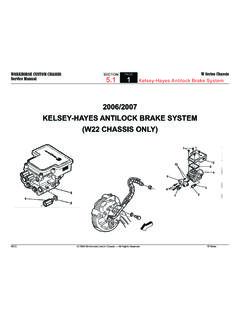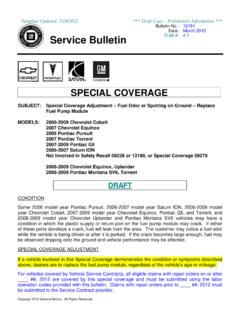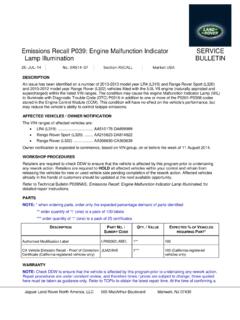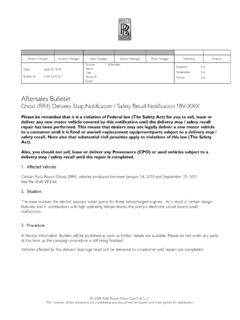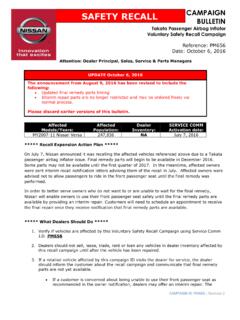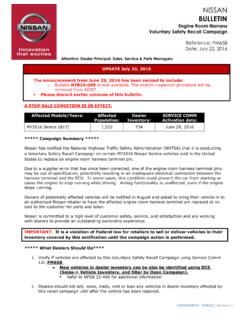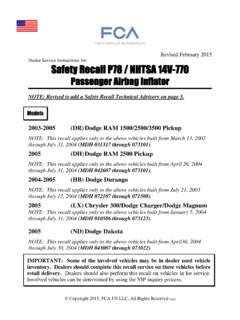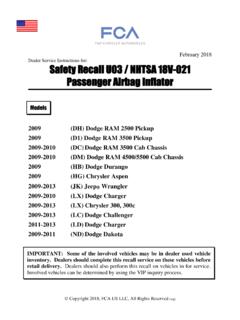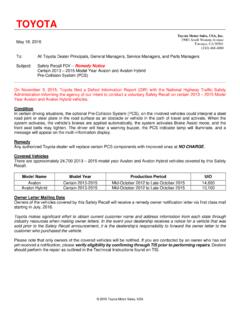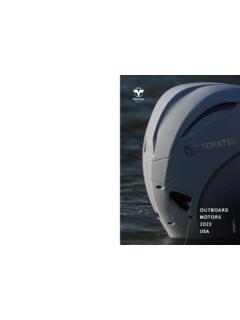Transcription of The Audi 1.8L and 2.0L Third Generation EA888 Engines
1 1 The Audi and Third Generation EA888 EngineseSelf-Study Program 9202432 Audi of America, LLC Service Training Created in the Created 11/2013 Course Number 920243 2013 Audi of America, LLC All rights reserved. Information contained in this manual is based on the latest information available at the time of printing and is subject to the copyright and other intellectual property rights of Audi of America, LLC., its affiliated companies and its licensors. All rights are reserved to make changes at any time without notice. No part of this document may be reproduced, stored in a retrieval system, or transmitted in any form or by any means, electronic, mechanical, photocopying, recording or otherwise, nor may these materials be modified or reposted to other sites without the prior expressed written permission of the requests for permission to copy and redistribute information should be referred to Audi of America, LLC.
2 Always check Technical Bulletins and the latest electronic service repair literature for information that may supersede any information included in this 2: 12/20133 ContentsIntroduction ..5 Development goals ..6 Brief technical description ..7 Technical features ..8 engine mechanicals ..10 Overview ..10 Cylinder block ..10 Oil pan ..11 Crankshaft assembly ..12 Chain drive ..14 Balance shafts ..15 Auxiliaries mounting bracket ..16 Cylinder head ..18 Integral exhaust manifold ..21 Positive crankcase ventilation ..23 Oil supply ..28 System overview ..28 Oil supply ..30 Oil filler cap ..32 Switchable piston cooling jets ..32 Cooling system ..34 System overview.
3 34 Innovative Thermal Management (ITM) ..36 Air supply and charging ..49 System overview ..49 Air routing system for transversely mounted Engines ..50 Air routing system for longitudinal mounted Engines ..51 Intake manifold ..52 Turbocharger ..53 Fuel system ..57 System overview ..57 Mixture formation / dual injection system ..58 Operating modes ..59 engine management system ..62 System overview example TFSI engine ..62 Differences between longitudinally and transversely mounted Engines ..64 Differences between components in the Engines with l and l displacement ..65 Component differences for the 2015 Audi S3 ..66 Differences between the exhaust turbochargers.
4 67 Differences between combustion methods ..68 Special tools ..69 Self Study Programs ..70 Knowledge Assessment ..714 This eSelf Study Program teaches a basic knowledge of the design and functions of new models, new automotive components or technologies. It is not a Repair Manual! All values given are intended as a guideline only. For maintenance and repair work, always refer to the current technical eSSP contains video links which you can use to access interactive design requirement was that the Engines be suit-able for use in all markets, including those where low grade fuel is prevalent. Please note: Some illustrations of the engine in this eSelf-Study Program are for the world-wide market.
5 With the North American introduction of the Third Generation EA888 Engines , the engine will not have a continuously adjust-able exhaust camshaft nor objectives of this eSelf Study Program:This eSelf-Study Program introduces you to the technology of the Third Generation of EA888 4 cylinder Engines . Upon completing this eSelf-Study Program, you will be able to answer the following questions: What are the key technical modifications behind the development of the EA888 engine family? How do the innovative, new technologies work? What changes do the and Engines bring to customer service?606_001 The launch of the new and TFSI Engines marks the beginning for the Third Generation of the successful EA888 four cylinder engine family from Audi.
6 The motives for this development are increasingly stringent exhaust emission standards, better fuel economy and reduced CO2 emissions. To achieve these goals, the Engines have been completely global engine is manufactured at Audi s Hungarian plant in Gy r; in Silao, Mexico; Shanghai and Dallan China. In the future it will also be produced in Changchun. Like the second Generation versions of this engine , it is available in both and displacements. It is used for a variety of vehicle platforms and Group brands and is available in a wide range of power find more about the modifications to the first and second Generation Engines , please refer to eSelf-Study Program 922903, The 4V TFSI engine with a detailed technical description of the first Generation engine , please refer to eSelf-Study Program 921703, The Audi Liter Chain-driven TFSI engine .
7 6CO2 reductionTo meet emission limits while reducing CO2 output, the following design modifications have been made:Modular adaptationTo use the Third Generation of the EA888 engine family as a "global engine " in the modular longitudinal application (MLB) and the modular transverse application (MQB), it was necessary to revise its dimensions, mounting and connecting goalsThe main goals for developing the Third Generation of the EA888 engine family were to meet more stringent exhaust emission standards and provide compatibility of the engine with various modular mounts and a dipstick are used if the engine is trans-versely mounted. If the engine is longitudinally mounted, use is made of engine supports and a sealing cap in place of a dipstick.
8 ** The initial offering of the 3rd Generation engine in the North American market will be equipped only with FSI. The dual injection system with both MPI and FSI will be introduced in later frictionThe chain tensioners have been optimized for the reduced oil pressure. In addition to this, the tensioning force of the chains has been reduced, in turn reducing , the crankshafts are made with smaller main bearing diameters which produce less poly-Vee belt drive configuration is identical for longitu-dinal and transverse mounted Engines . However, the alterna-tors and A/C compressors are *Friction and weight reduction Balance shafts partially mounted in needle bearings Smaller main crankshaft bearing diameter Lower oil level Reduced tensioning force in the auxiliary driveCylinder head Cylinder head with Integrated Exhaust Manifold (IEM) Weight-reduced exhaust turbocharger housing Electrical wastegate actuatorInjection FSI and MPI fuel injectors**Thermal management Rotary slide valve controlThe engineers in Ingolstadt placed special emphasis on the following priorities during the development cycle.
9 A high proportion of identical parts for all engine versions Reducing engine weight Minimizing intra- engine friction Increasing power output and torque in conjunction with good fuel economyThe following innovative, new technologies are featured: Exhaust manifold integrated into the cylinder head Dual injection system with direct and port injection ** New, compact turbocharger module with cast steel turbine housing, electrical wastegate actuator and oxygen sensor upstream of the turbine Innovative Thermal Management system with fully electronic coolant temperature control * The term downspeeding is used to describe the reduction in engine speed achieved by altering the overall transmission ratio.
10 Use of a drive ratio optimized for fuel efficiency makes it possible to achieve reductions in fuel consumption similar to those achievable by reducing engine displacement. The higher power output and average pressure level of turbocharged Engines allows the operating point to be shifted towards lower engine speeds and higher engine loads. This means that the engine can be operated in an rpm range that is more favorable in terms of fuel economy. Downspeeding concepts generally go hand in hand with downsizing concepts - a combination particularly well suited to turbocharged direct injection gasoline * The initial offering of the 3rd Generation engine in the North American market will be equipped only with FSI.
